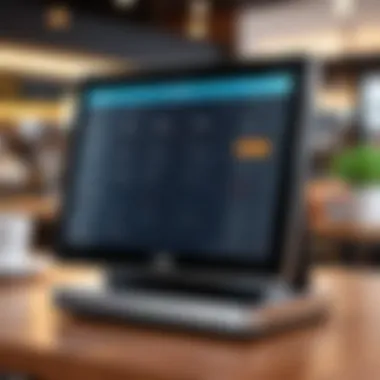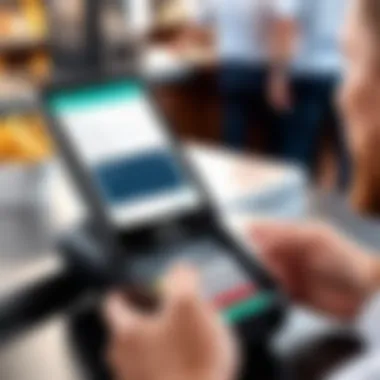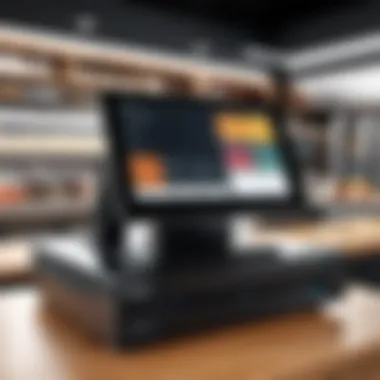Essential Insights on Restaurant POS System Software


Intro
In the restaurant industry, the significance of an efficient POS (Point of Sale) system cannot be understated. As the backbone of daily operations, a sophisticated POS system enables precise transaction management while offering insights into customer preferences and inventory. This article explores the critical aspects of POS system software tailored for restaurants, aiming to provide decision-makers with a clear understanding of functionalities, deployment strategies, and user considerations.
With the rise of technology in dining, understanding what a POS system offers becomes crucial. From processing payments to managing orders, the right POS solution can enhance overall operational efficiency. The focus will be on essential features, pricing models, and the impact of these systems on both finances and service delivery.
Key Features and Functionalities
Comprehensive Overview
The essence of a robust POS system revolves around its key features, which include order entry, payment processing, and reporting functionalities. A well-designed system streamlines the order process for waitstaff, reducing the time spent on entering orders and minimizing errors during busy hours.
- Order Management: Automated order routing to the kitchen ensures vital information reaches the chefs promptly, allowing for timely meal preparation.
- Payment Processing: Support for multiple payment methods, such as credit cards, digital wallets, and gift cards, enhances customer flexibility.
- Inventory Tracking: Real-time insights into stock levels help restaurant managers avoid over-ordering or stock shortages.
- Sales Reporting: Advanced reporting tools enable analysis of sales trends, daily revenue, and even staff performance, aiding strategic decisions.
Target Users
The primary users of POS system software in restaurants span various roles:
- Restaurant Owners: They focus on investing in systems that yield a good return by enhancing productivity.
- Managers: Often in charge of day-to-day operations, they utilize reporting tools to make informed decisions.
- Waitstaff: Quick and efficient order entry is essential for them, as they directly interact with customers.
- Kitchen Staff: Integration with order management helps streamline meal preparation based on current demand.
Each user cohort brings unique needs to the table, emphasizing the necessity for a system that can cater comprehensively to all.
Pricing Models and Cost Analysis
Breakdown of Pricing Tiers
Understanding costs associated with acquiring a POS system is vital for any restaurant operator. Systems can vary significantly in price depending on features and service tiers.
- Basic Tier: Offering essential functionalities at a lower cost, suitable for small establishments.
- Mid-Range Tier: Introducing more advanced reporting, customer management, and employee tracking features, ideal for growing businesses.
- Premium Tier: Typically includes all features, along with integrations for online ordering and loyalty programs, catering to large setups.
Additional Costs to Consider
Besides the purchase or subscription price, several hidden costs can emerge:
- Installation Fees: Some vendors charge for setup, particularly for more complex systems.
- Training Costs: Staff may require training to optimize use of new software, which can add to the initial expense.
- Support Plans: Ongoing technical support can come with additional fees, essential for maintaining system efficiency.
Investing in a suitable POS software is more than a simple purchase; it’s a strategic move that impacts every aspect of restaurant operation. By weighing the features against costs and understanding the target users, restaurants can make informed decisions that align with their business objectives.
Prolusion to POS Systems in Restaurants
The restaurant industry operates on efficiency and customer satisfaction. Point-of-sale (POS) systems play a critical role in achieving these objectives. They are much more than just transaction processors. A well-integrated POS system is essential for managing orders, payments, and inventory. Moreover, it provides insights that can shape the overall strategy of a restaurant. Understanding POS systems is crucial for industry decision-makers and technology professionals.
POS systems streamline operations by automating various tasks. For example, they can manage inventory in real-time, allowing restaurant staff to know when to reorder supplies. Additionally, effective order processing enhances speed and accuracy, leading to a better dining experience for customers. Therefore, an effective POS system can transform a restaurant's operational efficiency.
Defining POS Systems
A POS system refers to the technology that allows restaurants to take orders and process payments easily. Generally, it consists of hardware and software components. On the hardware side, there are devices like terminals, touch screens, and card readers. The software is responsible for managing tasks such as tracking sales, handling payments, and generating reports.
For the restaurant sector, a POS system can manage multiple functions:
- Sales processing: Handles both cash and credit transactions.
- Order tracking: Monitors customer orders from placement to kitchen completion.
- Inventory management: Tracks stock levels and alerts staff for restocking.
- Reporting function: Generates analytics on sales trends and customer preferences.
The combination of these features provides a fuller picture of restaurant operations, assisting in decision-making and strategy formulation.
The Evolution of POS in the Restaurant Sector
The journey of POS systems in the restaurant sector showcases rapid transformation. Initially, these systems were mainly cash registers that manually recorded transactions. Over time, they evolved into sophisticated digital platforms.


The introduction of touchscreen technology marked a significant turning point. This shift made it easier for staff to enter orders accurately and quickly. Subsequently, the development of cloud-based solutions allowed for even greater flexibility, enabling restaurant operators to access their data from anywhere. This adaptability has become especially relevant in the post-COVID world, where remote management capabilities are highly valued.
Furthermore, with advancements in technology, POS systems are increasingly incorporating functionalities that improve guest interactions. Features like mobile ordering, loyalty programs, and integration with payment wallets reflect the shifting expectations of customers. These trends emphasize the ongoing evolution of the customer experience in dining establishments.
"Understanding the evolution of POS systems is vital for professionals looking to adopt technologies that align with current market demands."
In summary, the significance of POS systems in restaurants intersects with technology, efficiency, and customer satisfaction. Their role in shaping operational processes cannot be overstated. Therefore, a comprehensive exploration of POS system software is imperative for restaurants aiming to enhance their operational framework.
Core Features of Restaurant POS Software
The core features of restaurant POS software play a crucial role in enabling establishments to operate efficiently. These systems are more than mere cash registers; they serve as the backbone of restaurant operations by facilitating a wide range of functions from managing orders to tracking inventory. Understanding these essential capabilities can help decision-makers choose the appropriate system that aligns with their specific needs.
Menu Management Capabilities
Menu management is fundamental to any restaurant's operations. With a robust POS system, staff can easily update menu items, prices, and descriptions in real time. This is particularly vital in dynamic environments that frequently change their offerings or run seasonal promotions. Such capabilities ensure that customers have access to the latest information about available dishes, enhancing their dining experience.
Additionally, many modern POS systems offer functionalities such as menu item categorization, allowing restaurants to organize their offerings logically. This not only aids in quicker server response times during peak hours but also helps in tracking the popularity of specific items. Understanding customer preferences through menu management can inform strategic decisions about promotions and inventory.
Order Processing and Tracking
Order processing is another critical aspect. Efficient order management ensures that food and drinks are prepared and served promptly. Advanced POS systems allow for seamless integration between the front-of-house and kitchen staff. Orders taken at the table can instantly transmit to kitchen displays, minimizing lag time and communication errors.
Furthermore, many POS systems offer features for tracking orders throughout the dining process. For instance, staff can update the order status in real-time, which keeps customers informed and improves overall satisfaction. This transparency also helps manage expectations during busy hours when delays might occur.
Payment Processing Options
The range of payment processing options available through POS systems has expanded significantly. Customers expect diverse methods to settle their bills, including credit cards, mobile wallets, and contactless payments. A system that supports multiple payment avenues not only enhances the customer experience but also increases the likelihood of receiving payment promptly and securely.
Furthermore, POS systems often include integrated tools for handling tips and split payments, catering to various customer preferences. This flexibility can lead to improved service efficiency and higher customer satisfaction, which is crucial in a competitive industry.
Inventory Management Features
Effective inventory management is vital for any restaurant to remain profitable. A comprehensive restaurant POS system typically includes features for monitoring inventory levels in real-time. This allows restaurant managers to assess stock levels and anticipate when to reorder items, thereby minimizing overstock and waste.
Some advanced systems provide analytics on inventory usage, offering insights into which items are frequently sold and which are not. This data enables restaurants to adjust their menus accordingly and improve cost management. Also, integrating inventory management with order processing can streamline operations, allowing for automatic updates when items are sold.
Reporting and Analytics Tools
Reporting and analytics are essential for strategic decision-making. High-quality POS systems come equipped with tools that generate various reports on sales, customer behavior, and operational efficiency. This data can provide valuable insights, guiding decisions on menu adjustments, staffing needs, and promotional strategies.
For instance, analyzing peak hours can help in optimizing staff schedules, while sales reports can identify top-selling items. Armed with this information, restaurant managers can make informed decisions that can significantly impact profit margins and customer satisfaction.
Evaluating Different POS Software Options
To choose the right POS software for a restaurant, evaluating different options is a critical process. The range of available software varies greatly in terms of capabilities, user interface, and cost. This evaluation informs decision-makers about which system aligns best with the restaurant's operational and financial goals.
When assessing POS software, one must consider specific elements such as functionality, ease of use, integration with existing systems, and scalability. The benefits of a well-evaluated POS system include increased efficiency, improved customer experience, and better data management. Furthermore, understanding comparisons between different software can help identify the best ROI for a restaurant.
In addition, examining user reviews and case studies provides insight into the real-world application of each system. Key considerations should also include vendor support and training resources offered, as these can greatly impact the implementation success.
"Choosing the right POS system can significantly influence a restaurant's operational efficiency and overall profitability."
Leading POS Software Providers
Several software providers stand out in the realm of restaurant POS systems. Each offers unique features tailored to enhance restaurant operations. Some notable providers include:
- Toast: Known for its robust features, including online ordering and a customizable interface.
- Square for Restaurants: Easy to use with transparent pricing, appealing to smaller establishments.
- Lightspeed: Offers rich customization options and strong inventory management features.
- Shopify POS: Integrates well with e-commerce, making it suitable for restaurants with retail components.
Each of these providers has carved a niche in the market, serving different types of restaurants, from fast-casual to fine dining. Understanding their offerings helps narrow down options based on the specific needs of the restaurant.


Comparative Analysis of Features and Pricing
A comparative analysis of features and pricing further aids in evaluating POS options. Key factors to analyze include:
- Feature Set: Does the software include essential capabilities such as inventory management, employee scheduling, and reporting tools?
- Pricing Models: How does each provider structure their pricing? Are there any hidden costs associated with payment processing or hardware?
- Usability: Is the software user-friendly? A complex interface may lead to longer training periods and decreased employee efficiency.
While some systems offer initial low pricing, ongoing fees can add up, impacting long-term costs. Analyzing both upfront and recurring expenses allows for a more accurate assessment of total cost of ownership. By examining these elements critically, restaurant owners can make an informed decision that suits their unique operational needs.
Implementation Strategies for POS Systems
Implementing a new Point of Sale (POS) system in a restaurant goes beyond just purchasing software. It involves carefully planning and executing strategies that ensure the system meets specific needs and operates effectively. The significance of implementing strategies cannot be overstated, as they not only facilitate smooth transitions but also maximize the potential benefits of the software. By understanding the core elements and considerations involved, businesses can achieve a successful integration into their daily operations.
Assessing Business Needs
Before selecting a POS system, assessing business needs is crucial. This step involves a thorough analysis of current operations. Stakeholders should identify the unique requirements of their restaurant. Considerations include:
- Type of Service: Is the restaurant fast-casual or fine dining? Each type may require different functionalities.
- Volume of Transactions: High-traffic environments might need faster processing options and more robust analytics tools.
- Menu Complexity: A diverse menu with frequent changes might necessitate a system that excels in menu management.
- Integration Needs: Identifying third-party software, such as accounting or inventory systems, helps determine compatibility.
Once specific needs are established, it becomes easier to narrow down options. Engaging with staff during this process can also yield valuable insights into operational challenges and desired features. This participatory approach not only aids in selection but also builds a sense of ownership among employees.
Transitioning from Legacy Systems
Many restaurants operate on legacy systems that may not support modern functionalities. Transitioning from these older systems can be challenging but is vital for improvement. A detailed plan can ease this transition. Here are some essential steps to consider:
- Data Migration: Ensure that customer and sales data from the legacy system can be transferred smoothly to the new POS. Data integrity must be maintained to avoid chaos during the switch.
- Employee Training: Introducing a new system requires proper training for employees. Providing sessions that focus on practical usage can improve comfort levels and confidence.
- Dual Running: For a time, consider running both systems in parallel. This allows staff to adjust while maintaining operational continuity.
- Customer Communication: If applicable, inform customers about changes in service processes, especially if these changes will affect them directly.
Implementing these strategies positions restaurants to leverage the full advantage of their new POS systems. Focusing on business needs and easing the transition can lead to a significant enhancement in operational efficiency, ultimately resulting in better customer experiences.
User Experience and Training
User experience and training play critical roles in the successful adoption of POS system software in the restaurant sector. These elements significantly affect not just the initial implementation but ongoing operations and customer satisfaction. If a POS system is difficult to use, it can lead to errors in orders, delays at the register, and ultimately a poor dining experience for customers. Therefore, it is essential to focus on creating a user-friendly system that employees can master quickly.
Importance of User-Friendly Interfaces
A user-friendly interface in POS software simplifies the interaction between the staff and the system. It facilitates a smooth workflow, making it easier for employees to enter orders, process payments, and manage inventory.
Here are some key benefits of having a user-friendly interface:
- Reduction in Training Time: A simple, intuitive design means employees can learn the system faster. This is particularly important in high-turnover environments like restaurants, where new staff members are frequently onboarded.
- Minimized Errors: A straightforward layout reduces the likelihood of input mistakes. For example, if the menu navigation is clear, servers are less likely to misplace orders.
- Enhanced Efficiency: Speed is crucial in busy restaurant settings. A well-designed interface allows staff to complete tasks quickly, improving the overall service quality and customer satisfaction.
In summary, a user-friendly POS system can translate to tangible benefits that impact both employee performance and customer experience, making it a vital consideration when selecting software.
Training Employees on New Systems
Training employees on new POS systems is not just about teaching them to click buttons. It encompasses comprehensive education on all features and functionalities to ensure seamless operation and integration into daily tasks.
Consider these aspects while training:
- Hands-On Practice: Offering employees the opportunity for hands-on training can be much more effective than merely providing a manual. Engaging with the system directly helps solidify their understanding.
- Simulated Scenarios: Implementing role-playing scenarios can prepare staff for real-life situations. This practice allows employees to learn to handle various situations, from busy rush hours to dealing with difficult customer queries.
- Continuous Support: Establish a structured system for ongoing support. Employees should know whom to reach out to for help or additional training as needed, ensuring that they are never left without guidance.
"Proper training not only enables staff to utilize the POS system effectively but also boosts their confidence, leading to a better guest experience."
By concentrating on these areas, restaurant owners can enhance the capability and readiness of their team, ensuring a smooth transition to the new POS system and eventual operational excellence.
Cost Considerations for POS Implementation
Understanding the cost implications associated with implementing a POS system is critical for any restaurant. The decision to integrate such software involves various financial factors that could influence both short-term and long-term operational success. Every choice made in this area can have significant consequences for the overall health of the business.


In this section, we will unpack the cost considerations for POS systems, ensuring decision-makers grasp the full scope of financial impact. The analysis will highlight initial setup fees, ongoing costs, and the necessity of maintenance. These elements are not just numbers; they are the foundation upon which effective restaurant management can stand.
Initial Setup and Licensing Fees
The initial setup and licensing fees often serve as the first barrier to adopting a new POS system. These costs can vary widely based on the complexity of the system and the specific capabilities desired. For instance, more advanced systems integrated with features like inventory management or customer relationship management may incur higher licensing fees.
Key elements of initial fees include:
- Hardware Costs: This entails the purchase of devices such as terminals, printers, and sometimes tablets. Sometimes these can be bundled with software packages, but they can still be a significant investment.
- Software Licensing: Many POS providers operate on a subscription model, which could range from monthly or yearly fees. The longer the commitment, the greater the potential discounts.
- Installation Fees: This might involve hiring professionals to set up the system, which can be an additional cost to consider.
- Training Costs: Ensuring staff are trained to use the POS system efficiently often calls for additional investment.
Proper planning is crucial. Many restaurants fail to account for every aspect mentioned above, which could lead to budget overruns and unexpected financial strain. Understanding these costs at the outset is essential for proper budgeting.
Ongoing Costs and Maintenance
Once the initial setup is complete, restaurants must also navigate ongoing costs. Maintenance of a POS system is an often-overlooked aspect that can make or break the financial viability of the software.
Here are some recurring costs to consider:
- Subscription Fees: Continuation of the subscription for software services, which may include updates and customer support. This is often billed monthly or annually.
- Maintenance and Support Costs: Having access to technical support is vital, but it comes at a cost. Some providers may have tiered pricing for varying levels of support.
- Hardware Upgrades: As technology advances, older hardware may need replacements or updates, which incurs additional expenses.
- Training and Retraining: Ongoing training might be necessary as staff turnover can lead to repeated costs for onboarding.
The total cost of ownership of a POS system extends far beyond the initial purchase price.
"Considering both initial and ongoing costs ensures a complete understanding of the financial obligations associated with a POS system."
The Future of POS Systems in the Restaurant Industry
The landscape of restaurant management is evolving. Point of Sale (POS) systems are critical to this change. Understanding the future of these systems is essential for owners who want to stay relevant and competitive. New technologies and trends are shaping how restaurants operate. This section identifies key elements that can enhance restaurant efficiency and customer satisfaction.
Emerging Technologies and Trends
Emerging technologies are redefining the capabilities of POS systems. Innovations like cloud computing, mobile payment solutions, and contactless transactions are gaining traction. These features offer several advantages:
- Cloud-Based Solutions: Management becomes more accessible with data stored online. Business owners can access reports and analyses from anywhere, making decision-making easier.
- Mobile Payment: Customers expect flexibility in payments. Mobile solutions enable quick transactions, reducing wait times.
- Contactless Payments: Safety remains a priority. Offering contactless transactions can cater to health-conscious consumers.
Other trends include integrating POS systems with marketing tools. This approach can streamline promotions, loyalty programs, and customer relationship management. Advanced analytics tools play a vital role as well, allowing for deeper insights into customer behavior. By understanding customer preferences, restaurants can tailor services and menus, establishing a competitive edge.
The Impact of AI and Automation
Artificial intelligence (AI) and automation are reshaping the restaurant experience. These advancements bring remarkable benefits:
- Enhanced Customer Service: AI can assist in streamlining operations. Chatbots handle reservations and inquiries, freeing staff to focus on guest relations.
- Inventory Management: AI algorithms predict inventory needs based on historical data. This automation reduces waste and ensures products are available when needed.
- Dynamic Pricing Models: Some systems enable dynamic pricing strategies. AI monitors demand fluctuations, allowing for optimal pricing to maximize revenue.
Automation also extends to the kitchen. Smart kitchen devices interact with POS systems to track orders real-time, improving efficiency. This ensures that communication gaps between front-of-house and back-of-house teams are reduced.
"Understanding the future of POS systems is vital for restaurant owners who want to stay competitive in a rapidly changing landscape."
As the restaurant industry continues to adapt, so too should the tools utilized for management and service delivery.
Finale
The conclusion serves as a critical element in this exploration of POS system software tailored for the restaurant industry. It encapsulates the journey through key findings, insights, and the implications of implementing such systems in modern dining establishments. Decision-makers must recognize how POS systems are not simply tools for transaction processing; they integrate various facets of restaurant operations to streamline efficiency, enhance customer experiences, and provide invaluable data for strategic decision-making.
Summary of Key Insights
Through this article, we have examined multiple aspects of POS systems, including their defining features, functionalities, and the methodologies for effective implementation. A few key insights include:
- Core Features: Effective POS software includes essential features such as menu management, order processing, and detailed reporting tools that cater specifically to the restaurant environment.
- Cost Factors: Understanding the cost structure for initial setup and ongoing expenses is crucial for budget-conscious decision-makers.
- User Training: A user-friendly interface simplifies training, increasing employee buy-in and reducing operational downtime.
- Emerging Trends: Staying informed about trends such as AI and automation can position restaurants better, ensuring they remain competitive in a rapidly evolving market.
Final Thoughts on Choosing a POS System
Choosing the right POS system is not a trivial task. It requires a careful analysis of the restaurant's specific needs, current capabilities, and future aspirations. Consider the following points:
- Customization: Look for flexibility in features that can adapt to unique operational demands.
- Support and Maintenance: Engage with vendors who provide robust support to assist with software updates and troubleshooting.
- Returned Investment: Understand how the choice of POS can enhance revenue through improved customer service and operational efficiency.
In summary, the decision to implement a POS system reflects more than just a financial investment; it indicates a commitment to elevating the restaurant's overall quality and performance. Making an informed choice will lead to significant long-term benefits, positioning the restaurant for both immediate success and sustainable growth in the dynamic landscape of the food service industry.













